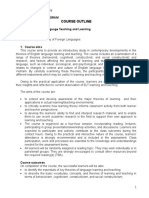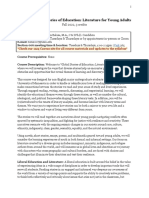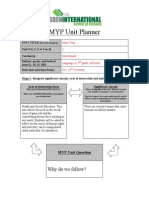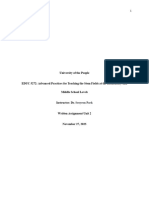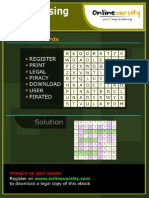University of The People EDUC 5281 Unit 7 Written Assignment October 22, 2023 Instructor: DR Kristin Jones
University of The People EDUC 5281 Unit 7 Written Assignment October 22, 2023 Instructor: DR Kristin Jones
Uploaded by
TomCopyright:
Available Formats
University of The People EDUC 5281 Unit 7 Written Assignment October 22, 2023 Instructor: DR Kristin Jones
University of The People EDUC 5281 Unit 7 Written Assignment October 22, 2023 Instructor: DR Kristin Jones
Uploaded by
TomOriginal Description:
Original Title
Copyright
Available Formats
Share this document
Did you find this document useful?
Is this content inappropriate?
Copyright:
Available Formats
University of The People EDUC 5281 Unit 7 Written Assignment October 22, 2023 Instructor: DR Kristin Jones
University of The People EDUC 5281 Unit 7 Written Assignment October 22, 2023 Instructor: DR Kristin Jones
Uploaded by
TomCopyright:
Available Formats
0
University of the People
EDUC 5281
Unit 7 written assignment
October 22, 2023
Instructor: Dr Kristin Jones
1
Introduction
Creating compelling and interesting instructional programs for students studying
Language and Literature is a gratifying endeavor for teachers. Delivering instructional sessions
that captivate students' interest, cultivate their affection for language, and kindle their enthusiasm
for reading may have a profound effect on their educational journey. As education progresses, it
becomes increasingly crucial for teachers to adjust and integrate novel approaches to engage
their pupils (Teaching Channel, 2018). According to the acclaimed scholar and writer, John
Dewey, if we instruct present-day students in the same manner as we did with past students, we
deprive them of their future (Williams, 2022). This remark emphasizes the necessity of adapting
our teaching methods to cater to the varied interests and learning preferences of modern
Language and Literature students. This article aims to present an exemplary lesson plan for a
Grade 9 Language and Literature class that emphasizes the reflection of social themes in
literature.
The lesson plan will include the following areas:
1. Grade Level/ Content Area/ Topic
2. Fiction or Non-fiction Text
3. Teaching Strategies
4. Activities
Content Area/ Grade Level: Grade 9 - Language and Literature
1. Topic: Literature as a Tool for Social Problem Analysis: Michelle Alexander's "The New Jim
Crow: Mass Incarceration in the Age of Colorblind"
2
This book offers a compelling and intellectually stimulating analysis of the American criminal
justice system and its influence on communities of color. Selecting this particular work is crucial
since it tackles pertinent societal concerns such as racial prejudice, systematic inequity, and
widespread imprisonment, all of which are of utmost importance for students to comprehend and
actively participate in within contemporary society.
II. Teaching Strategies
A. Literature Circles
Teacher Process: The instructor will present the subject of societal concerns and provide a
concise explanation of the significance of the book "The New Jim Crow." Prior to commencing
the literary circles, the instructor will partition the class into little clusters, guaranteeing that each
cluster has a varied assortment of pupils. The instructor will present a comprehensive
introduction to literary circles, elucidating the responsibilities of each group participant (e.g.,
discussion director, summarizer, connector, word wizard, etc.) and outlining the operational
procedures that will be followed for the duration of the unit.
Student process: Within the context of literary circles, students will engage in the collective
reading of "The New Jim Crow" in small groups, assuming distinct roles to effectively foster
debates. The discussion director will generate inquiries to drive group conversations on different
chapters, while the summarizer will offer succinct synopses of the main ideas. The connector
will establish a connection between the topics of the book and current events, while the word
wizard will delve into complex vocabulary concepts. Students will convene often in literary
circles to analyze their discoveries, exchange perspectives, and participate in rigorous
deliberations on the societal problems depicted in the book.
3
B. Writing Activity - Argumentative Essay
Teacher process: In order to prepare students for the writing task, the instructor will facilitate
class discussions and deliver concise lessons on argumentative writing strategies, including the
construction of a thesis statement, the use of supporting evidence, and the consideration of
counterarguments. The instructor will further oversee brainstorming sessions to assist students in
generating ideas pertaining to the concepts and topics discussed in "The New Jim Crow." In
addition, the teacher will provide guidance to students in performing research to locate
corroborating evidence and pertinent facts to enhance their arguments.
Student process: It is expected that students would draft persuasive essays on one of the social
issues raised in "The New Jim Crow." They will narrow the topic of their writings to one facet of
the criminal justice system or racial inequity. The instructor will set out class time for students to
concentrate on their essays and offer individualized suggestions and assistance to those who need
it. The students will need to use evidence from the text and other sources to back up their
statements and rebuttals.
Students in 9th-grade Language and Literature will benefit from this unit because it will
encourage them to think critically about contemporary social concerns, appreciate the potential
of literature to address these issues and hone their abilities in analytical and persuasive writing.
Incorporating "The New Jim Crow" as a supplementary work with literary circles and
argumentative essay exercises will provide students with a rich and comprehensive education.
Students are able to work together, engage in critical thinking, and articulate their views well in
both oral and written forms as a result of participating in these activities.
4
References
Alexander, M. (2010). The New Jim Crow: Mass Incarceration in the Age of Colorblindness. The
New Press.
Teaching Channel (2018). Five steps to revision: Using warm and cool feedback. Retrieved from
https://www.teachingchannel.org/video/revising-essays-nea.
Williams, R. (2022). Evolving teaching practices for modern learners. Education Today, 54(6),
12-18.
You might also like
- Storm BoyDocument28 pagesStorm Boyapi-3722307330% (1)
- Madeline Decker - Ci 403 - Just Mercy Unit Lesson PlansDocument35 pagesMadeline Decker - Ci 403 - Just Mercy Unit Lesson Plansapi-355737575No ratings yet
- Tkam MypDocument5 pagesTkam Mypapi-300759812100% (1)
- 2022-23 Fall - American Dilemmas - SyllabusDocument10 pages2022-23 Fall - American Dilemmas - SyllabusSaiki HoNo ratings yet
- Ucla 426Document5 pagesUcla 426api-241800671No ratings yet
- ENG212 Course Outline Winter 2011Document10 pagesENG212 Course Outline Winter 2011Elizabeth CopeNo ratings yet
- Sample Psychological Report Confidential PDFDocument19 pagesSample Psychological Report Confidential PDFTeofztogo Palsimon100% (1)
- Roles and ResponsibilitiesDocument21 pagesRoles and ResponsibilitiesQifaysVg67% (3)
- Shepley 7372 DraftDocument10 pagesShepley 7372 Draftapi-638081178No ratings yet
- Unit Plan: Baggage Stored, Perspective ExploredDocument30 pagesUnit Plan: Baggage Stored, Perspective Exploredapi-509984039No ratings yet
- Secondary English Language Arts: Revised ed:TPA Lesson Plan TemplateDocument9 pagesSecondary English Language Arts: Revised ed:TPA Lesson Plan Templateapi-341978939No ratings yet
- Movement and Movements Syl Lab Us Spring 2019Document7 pagesMovement and Movements Syl Lab Us Spring 2019David GomezNo ratings yet
- Hagoodh LessonDocument5 pagesHagoodh Lessonapi-502273867No ratings yet
- CV (Web)Document6 pagesCV (Web)Dalyn LuedtkeNo ratings yet
- FinalDocument8 pagesFinalapi-402106958No ratings yet
- Interactive Read Aloud Lesson 2Document8 pagesInteractive Read Aloud Lesson 2api-399873247No ratings yet
- Itag SyllabusDocument6 pagesItag Syllabusapi-350871217No ratings yet
- 07faculty Retreat Poster - Feb3Document1 page07faculty Retreat Poster - Feb3saharchNo ratings yet
- Decision-Making in Times of Injustice Lesson 2Document9 pagesDecision-Making in Times of Injustice Lesson 2Facing History and Ourselves100% (1)
- La Cosecha - Teaching From A Social Justice Perspective Presentation To ShareDocument29 pagesLa Cosecha - Teaching From A Social Justice Perspective Presentation To Shareapi-589645770No ratings yet
- Standard 3 RationaleDocument4 pagesStandard 3 Rationaleapi-318175030No ratings yet
- BPED 3B - Topic 3-Multicultural LiteracyDocument12 pagesBPED 3B - Topic 3-Multicultural LiteracyAnton Rafael SiapnoNo ratings yet
- Interactive Read Aloud Lesson 1Document10 pagesInteractive Read Aloud Lesson 1api-399873247No ratings yet
- Syllabus CRP 5311Document12 pagesSyllabus CRP 5311Gloria Lambo GillacoNo ratings yet
- Secondary English Language Arts: Revised ed:TPA Lesson Plan TemplateDocument8 pagesSecondary English Language Arts: Revised ed:TPA Lesson Plan Templateapi-341978939No ratings yet
- This Content Downloaded From 115.164.59.108 On Thu, 17 Nov 2022 13:39:13 UTCDocument22 pagesThis Content Downloaded From 115.164.59.108 On Thu, 17 Nov 2022 13:39:13 UTCOmniaNo ratings yet
- Academic Outcomes Lesson PlansDocument6 pagesAcademic Outcomes Lesson Plansapi-524951406No ratings yet
- DigitalunitplantemplateDocument6 pagesDigitalunitplantemplateapi-269195092No ratings yet
- Civics Lesson PlanDocument8 pagesCivics Lesson Planapi-309745875No ratings yet
- Man: A Course of Study As Supplemental Curriculum in The Ghristian School EnvironmentDocument14 pagesMan: A Course of Study As Supplemental Curriculum in The Ghristian School EnvironmentJosé Félix Angulo RascoNo ratings yet
- Annotation Scaffolding NewestDocument4 pagesAnnotation Scaffolding NewestjosefskNo ratings yet
- Multi Cultural Literature Unit PlanDocument21 pagesMulti Cultural Literature Unit Planapi-252047277100% (1)
- Amy Case 3Document4 pagesAmy Case 3api-306923013No ratings yet
- Constructivism in An Intermediate Grade Classroom.: ETEC 530, Assignment #1 Jeremy InschoDocument6 pagesConstructivism in An Intermediate Grade Classroom.: ETEC 530, Assignment #1 Jeremy InschoJeremy InschoNo ratings yet
- Revitalize Your Teaching Creative ApproaDocument13 pagesRevitalize Your Teaching Creative ApproaGesa Atras Fathurrahman 2101110347No ratings yet
- Using Collaborative Writing Tools in The Secondary English Classroom: Twitter, Fan Fiction and The CrucibleDocument8 pagesUsing Collaborative Writing Tools in The Secondary English Classroom: Twitter, Fan Fiction and The CrucibleBeth SummerNo ratings yet
- RWS 1302 Syllabus Spring 2023 (22373) - 1Document12 pagesRWS 1302 Syllabus Spring 2023 (22373) - 1Shravan PawarNo ratings yet
- History 30 - Unit OneDocument28 pagesHistory 30 - Unit OnethomsonjuliamNo ratings yet
- GCWORLD Coursebook Draft - 1Document23 pagesGCWORLD Coursebook Draft - 1Pre Loved OlshoppeNo ratings yet
- Theories of Language Learning & Teaching (Rev1)Document10 pagesTheories of Language Learning & Teaching (Rev1)Huy Nguyễn0% (1)
- Social and Radical ConstructivismDocument12 pagesSocial and Radical ConstructivismAmbrose Hans AggabaoNo ratings yet
- Syllabus SyllabusDocument6 pagesSyllabus Syllabusel.capaneoNo ratings yet
- Constructivist PedagogyDocument7 pagesConstructivist Pedagogyapi-281038892No ratings yet
- CI 1124 SyllabusDocument16 pagesCI 1124 SyllabusTomNo ratings yet
- Maus Unit Plan PDFDocument5 pagesMaus Unit Plan PDFcollin_macdonal6612No ratings yet
- Bielaczyc and Collins-Learning Communities in ClassroomsDocument21 pagesBielaczyc and Collins-Learning Communities in Classroomsushuaia7745No ratings yet
- Strategies in Teaching Social ScienceDocument6 pagesStrategies in Teaching Social ScienceIMELDA HINDANGNo ratings yet
- Sapere 1: Pathfinder URLDocument13 pagesSapere 1: Pathfinder URLballcoach76No ratings yet
- March UnitplanDocument18 pagesMarch Unitplanapi-351131078No ratings yet
- Critical LiteracyDocument3 pagesCritical LiteracyLaurenz Miguel MercadoNo ratings yet
- Marquis - Assign3 - Unit Plan EssayDocument27 pagesMarquis - Assign3 - Unit Plan Essayapi-310123009No ratings yet
- Journal of Art For LifeDocument18 pagesJournal of Art For LifeSopyan AhmadNo ratings yet
- Module 8 Building LiteracyDocument11 pagesModule 8 Building LiteracyDesiree Kaye MarianoNo ratings yet
- Grossman Wineburg WoolworthDocument100 pagesGrossman Wineburg WoolworthYadhu KrishnanNo ratings yet
- EDMC 532 - SyllabusDocument10 pagesEDMC 532 - SyllabusDjolikNo ratings yet
- Liazos Social Studies 68ec Syllabus September 2015Document9 pagesLiazos Social Studies 68ec Syllabus September 2015Brian KyaloNo ratings yet
- Mine!Document27 pagesMine!Magali MeacaNo ratings yet
- Final Project - SnowDocument22 pagesFinal Project - Snowapi-506734426No ratings yet
- Action Learning Literature ReviewDocument4 pagesAction Learning Literature Reviewea84k86s100% (1)
- School Culture Literature ReviewDocument4 pagesSchool Culture Literature Reviewc5e83cmh100% (1)
- College Teaching Studies in Methods of Teaching in the CollegeFrom EverandCollege Teaching Studies in Methods of Teaching in the CollegeNo ratings yet
- Unit 2 Wa Educ 5281Document4 pagesUnit 2 Wa Educ 5281TomNo ratings yet
- U5 Wa Educ 5410-1Document7 pagesU5 Wa Educ 5410-1Tom100% (1)
- Uinit 1 Wa Educ 5470 RevisedDocument7 pagesUinit 1 Wa Educ 5470 RevisedTomNo ratings yet
- Unit 2 Wa Educ 5282Document7 pagesUnit 2 Wa Educ 5282TomNo ratings yet
- U7 Wa 5410Document5 pagesU7 Wa 5410TomNo ratings yet
- Unit 1 Wa Educ 5910Document6 pagesUnit 1 Wa Educ 5910TomNo ratings yet
- Unit 2 Wa Educ 5272-1Document6 pagesUnit 2 Wa Educ 5272-1TomNo ratings yet
- U5 Wa Educ 5470-1Document6 pagesU5 Wa Educ 5470-1TomNo ratings yet
- Unit 2 Wa Educ 5470Document7 pagesUnit 2 Wa Educ 5470TomNo ratings yet
- Unit 2 Wa Educ 5271Document7 pagesUnit 2 Wa Educ 5271TomNo ratings yet
- U4 Wa Educ 5281-1Document6 pagesU4 Wa Educ 5281-1TomNo ratings yet
- U6 Wa Educ 5282Document6 pagesU6 Wa Educ 5282TomNo ratings yet
- Proposal GlobalDocument8 pagesProposal GlobalAmelia Intan SaputriNo ratings yet
- Satir Transformational Systemic Therapy in Brief PDFDocument5 pagesSatir Transformational Systemic Therapy in Brief PDFRuth Foff100% (1)
- IQ102Document16 pagesIQ102oicfbdNo ratings yet
- LS1 English Module 1 Lesson 1 LPDocument4 pagesLS1 English Module 1 Lesson 1 LPMEENA PEREZNo ratings yet
- Lesson Plan 2Document4 pagesLesson Plan 2api-248521749No ratings yet
- DLPDocument2 pagesDLPLingerfaith Mayor MoralesNo ratings yet
- Bill of Rights LessonDocument2 pagesBill of Rights Lessonapi-285427223No ratings yet
- Modals of Obligations - ReviewDocument10 pagesModals of Obligations - ReviewBahar EmirdağNo ratings yet
- Revisiting DSKP - PrimaryDocument36 pagesRevisiting DSKP - PrimaryKRIS LEONG JIA JIAN KPM-GuruNo ratings yet
- Empowerment Technologies - The Features of Web 2Document3 pagesEmpowerment Technologies - The Features of Web 2George Silandote89% (9)
- AJAX Using JavaDocument166 pagesAJAX Using JavaPartho BoraNo ratings yet
- Bartending NC IIDocument84 pagesBartending NC IIAlleirbag Fernandez Padilla75% (4)
- Book in A Bag Lesson PlanDocument3 pagesBook in A Bag Lesson Planapi-509266258No ratings yet
- Overview Of: Discussion of Results and ReflectionDocument28 pagesOverview Of: Discussion of Results and ReflectionAi LeneNo ratings yet
- Project Report On Training and DevelopmentDocument68 pagesProject Report On Training and DevelopmentGuru100% (1)
- MOA and Parental ConsentDocument4 pagesMOA and Parental Consentgary galang100% (1)
- Whitman-Hanson Grad 2010Document32 pagesWhitman-Hanson Grad 2010Express EditorNo ratings yet
- Microsoft PowerPoint - Thieu Nang - Session 7Document47 pagesMicrosoft PowerPoint - Thieu Nang - Session 7Nguyễn Thu Trang100% (1)
- Anth 121AC F13 SyllabusDocument10 pagesAnth 121AC F13 SyllabusVictor MiaoNo ratings yet
- Testimonials 2018 Harvard Law SchoolDocument6 pagesTestimonials 2018 Harvard Law SchoolRodrigo SanzNo ratings yet
- Course ReflecDocument8 pagesCourse Reflecapi-301376054100% (1)
- Numeracy Professional Skills Test Practice Test 2: First Name SurnameDocument29 pagesNumeracy Professional Skills Test Practice Test 2: First Name SurnameblueNo ratings yet
- Department of Education: Republic of The PhilippinesDocument2 pagesDepartment of Education: Republic of The Philippinesmarco medurandaNo ratings yet
- George Pastor - Adaptive Teaching GuideDocument4 pagesGeorge Pastor - Adaptive Teaching GuideGeorge L PastorNo ratings yet
- Grade 3 DLL MAPEH 3 Q4 Week 1Document3 pagesGrade 3 DLL MAPEH 3 Q4 Week 1Sharmaine Joy Salvadico100% (2)
- Lesson A: Unit 4: PossessionsDocument2 pagesLesson A: Unit 4: PossessionsEnrique CentyNo ratings yet
- Syllabus 020Document3 pagesSyllabus 020andrewCNo ratings yet
- Welcome To Mrs. Bouma S First Grade O.W.L S: Classroom Management PlanDocument23 pagesWelcome To Mrs. Bouma S First Grade O.W.L S: Classroom Management PlanelizabethboumaNo ratings yet







































